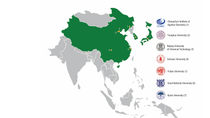NAO: accelerating open innovation through successful science collaboration

BASF fully utilizes its strength as the world’s leading chemical company to continuously invest in innovations to introduce sustainable solutions into the market. To expand research and innovation in Asia Pacific, BASF is closely collaborating with the region’s top universities and institutes within the platform of the Network for Advanced Materials Open Research (NAO). Established in March 2014 in collaboration with leading universities and research institutes in China, Japan and South Korea where this BASF Postdoctoral Research Center in Asia Pacific initiates, NAO negotiates and establishes the legal framework of R&D collaborations with the universities thus facilitating the access between BASF researchers and academia in Asia.
As part of BASF’s global collaborative network with the scientific community, NAO aims to foster open innovations by providing a regional platform for BASF scientists to work together with academics from top Asian universities on material science, modeling and synthesis methods.
"Entrepreneurship, creativity and collaboration are the main factors of successful innovation," said Dr. Harald Lauke, President, Advanced Materials & Systems Research, Regional Research Representative Asia Pacific, BASF. NAO integrates the three factors, supports and promotes close collaboration in the field of advanced materials research, enabling all partners to extend their scientific horizon to develop sustainable solutions.
An important aspect of the open research concept is that BASF is connecting experts from different countries to form a dynamic collaborative platform for exchanging ideas and co-creating new solutions. For academic researchers, BASF's know-how of the industry and market trends, as well as its rich experience in translating research results into products and processes, means a lot to them. "Open Research provides a channel between industry and academia,” said Prof. Yongfeng Men, Changchun Institute of Applied Chemistry (CIAC), Chinese Academy of Science. “Collaborating with BASF helps in the justification of our research directions, and translates research results to products and industry processes. This brings a great sense of achievement for people from academia."
Claudia Staudt, Senior Manager of Scouting and Open Research Center Asia Pacific, said her work aiming to build a strong regional cluster with interaction between industry and academia. “Frequent discussions and face-to-face meetings like the biannual NAO days enable us to provide an ideal surrounding for post-docs further developing themselves in a highly motivated community that accelerates the transfer of innovation to products,” said Claudia.
With hands-on experience through the NAO projects, postdoc students have the opportunity to discuss and exchange ideas with BASF researchers and professors from top universities and institutes, helping lay the foundation to become potential industry researchers. Xiaohui Li had successfully developed his scientific and personal competencies within NAO during his postdoc, and was hired at BASF in Shanghai in January 2016. "NAO is like a bridge between the universities and the company, also connecting my past experience with future career opportunities," he said.
Over the last two years, professors, postdoc students and BASF researchers have been working together on 28 projects through the NAO platform. In a project with Hanyang University, Seoul, for example, researchers worked on the fatigue life prediction of wind turbine blades of composites to provide an effective analysis tool for blade design in the wind industry. Another project with the Chinese University of Hong Kong aimed at developing a novel process to produce non-sticky solid particles from a liquid, which will be useful for the construction industry.
In 2014, the first transfer of the key results from some projects to the business units was completed. Currently, there are 13 active projects operating with focus on coatings, composites, functional polymers and additives.
Experts in polymer physics modeling from Fudan University, for example, are working on a collaborative project with BASF in the field of nano-hybrid PU/Polyacrylate systems. The project team has already reached a significant milestone and developed a powerful tool to optimize formulations for coatings and insulation applications. This multidisciplinary approach combining modeling and experimental work was the key factor for success.
"An important source of innovation, cooperation with outstanding scientists via the NAO platform, enables BASF to gain access to new technologies and explore new business areas," said Dr. Sébastien Garnier, former Senior Manager of Scouting and Open Research Center Asia Pacific, BASF. "NAO has become an important bridge between BASF and the academic community in Asia Pacific. I believe with our continuous efforts we are expecting more creative and viable ideas from this network in future."
"I really appreciate our partnership in the NAO project. BASF shows the commitment and dedication of long-term vision, and an open mindset towards diversity," said Prof. Feng Qiu from the Department of Macromolecular Science of Fudan University. "I look forward to a long-term collaboration between my department and BASF. I believe this will bring win-win to both parties."
"I look forward to a long-term collaboration between my department and BASF. I believe this will bring win-win to both parties."
Prof. Feng Qiu, Department of Macromolecular Science of Fudan University